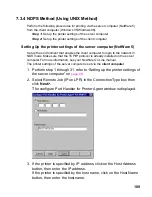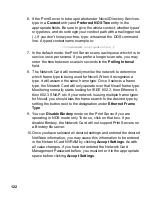
122
6. If the Print Server is to be operated under Novell Directory Services,
type in a Context entry and Preferred NDS Tree entry in the
appropriate fields. Be sure to give the
whole
context, whether
typed
or
typeless
, and do not begin your context path with a trailing period
(.). If you don't know your tree, type:
whoami
at the DOS command
line. A
typed
context name example is:
ou=standard.ou=organization_1
7. In the default mode, the Print Server scans each queue which it is to
service once per second. If you prefer a longer scan rate, you may
enter the time between scans in seconds in the Polling Interval
field.
8. The Network Card will normally monitor the network to determine
which frame type is being used for Novell. When it recognizes a
type, it will assume the same frame type. Once it selects a frame
type, the Network Card will only operate over that Novell frame type.
Monitoring normally starts looking for IEEE 802.3, then Ethernet II,
then 802.3 SNAP, etc. If your network is using multiple frame types
for Novell, you should bias the frame search to the desired type by
setting the button next to the designation under Ethernet Frame
Type.
9. You can Disable Bindery mode on the Print Server if you are
operating in NDS mode only. To do so, click on that box. If you
disable Bindery, the Network Card will not support Print Servers on
a Bindery file server.
10. Once you have selected all desired settings and entered the desired
NetWare information, you may cause this information to be entered
in the Network Card NVRAM by clicking Accept Settings. As with
all value changes, if you have not entered the Network Card
Management Password before, you must enter it in the appropriate
space before clicking Accept Settings.
















































